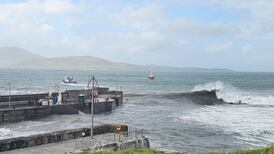It’s that time of year again when the gardeners of Ireland are divided into the haves and the have nots – those who have grown blue hydrangeas and those who haven’t because of all the bother that might involve. (There are others of course who can’t stand the sight of any hydrangea, but they’re excused from reading this first part and rejoin the article further on – when the vexed question of the blue rose raises its possibly purple head.)
Well-intentioned advisers have been blue in the face telling the deprived ones that they can turn their hydrangeas the same colour by adding various remedies to the soil to make it less alkaline and more acidic. (Or is it the other way around?).
They may also be told to confine their hesitant hydrangea to a suitably treated container in the hopes that the cuttings they stole from a beautiful blue bush in Kerry last year will come up blue in Dublin – maybe in time to coincide with the Dubs’ winning of yet another All-Ireland.
But why are some counties full of fortunate gardeners who don’t have to go to such bother? Why do they not have to lift a finger, nor even a bottle of aluminium sulphate to get the desired cerulean or azure effect?
READ MORE
To find the answer to that you only have to reach for your handy volume of Teagasc’s Soil Fertility Atlas of Ireland.
Every home should have one, but failing that you can easily tap into it online.
There you will find, alphabetically listed, detailed maps of every county in Ireland, with a complete breakdown of their soil conditions and the crops most suitable for growing there.
Thus the blue hydrangea fanatic will learn that whereas in Kerry only 19 per cent of soils have a pH of greater than 6.2, the corresponding figure in Dublin is 54 per cent.
So there’s your answer: it’s a question of alkaline versus acidic. (I hope you’re paying attention down there at the back: I’ll be asking questions later.)
But the battle of the hydrangeas is in the ha’penny place compared to the wars of the blue roses. It being high summer, roses are general all over Ireland. They fill the nation’s flowerbeds in garden and park with a kaleidoscope of colour and, given the right attention and some half-decent weather, they could continue doing so well into deepest autumn.
But one colour will be virtually absent. Blue. There are several roses in contention for the title “Blue Rose”, but the jury is still out on that description when it comes to roses that you can buy from your local garden centre. They have lovely names – “Blue Moon”, “Blue Girl” and “Rhapsody in Blue” to name some of the front runners. To misquote Father Ted, they all have lovely blossoms – but the question of their “blueness” has been known to provoke quite animated discussion.
Rose-lovers are a genteel lot, so it hasn’t quite come to blows, but mutters of “Purple”, “Pink” and “Mauve” have been heard behind the evergreen hedges of suburbia.There has even been one reported outbreak of “Violet”.
The quest for the definitive rose with a true blue hue has preoccupied rose breeders over many decades with the prospect of also growing their bank balance considerably if they succeed. One eminent British rose authority estimated that figure at over £100 million.
There was one big breakthrough in 2011 when the Japanese company Suntory, working with the plant scientists of the Australian company Florigene, announced that it had genetically engineered the creation of a blue rose.
Roses have no blue gene of their own, so the researchers had taken the delphinidin gene from a pansy and inserted it into a mauve “Cardinal de Richelieu” rose. The company called the resultant new rose “Applause” and soon was selling it on the American florists’ market for $24 a single stem. It described the rose as “a popular choice as a gift for special occasions, including proposals, anniversaries and birthdays.”
Some cynical nay-sayers greeted the arrival of “Applause” with a slow handclap.
One or two American online critics were so faint in their praise that they used the word “Lavender”. (Lavender is of course a shade of blue, but that’s not blue enough for some rose aficionados.)
“Applause” certainly is a shade of blue, but the bad news is that you won’t be able to buy it and wow the neighbours by planting it in your front garden. In reply to a recent query from one hopeful Irish gardening enthusiast a company spokesperson confirmed: “The Suntory Blue Rose Applause in only available as a fresh cut rose for the North American market. Suntory Flowers does not sell the material for gardening purposes.”
Oh well, back to the potting shed!
* The annual Rose Festival 2023 returns to St Anne’s Park in Raheny/Clontarf on the weekend of the 15th and 16th of July. The park’s rose garden, one of Dublin’s treasures, is a must-see.
















